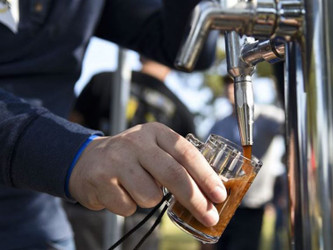What Is the Difference Between Stout and Porter?
Posted by Julia Brodsky on 24th Dec 2018
Two beers, both alike in color, in a fair pub where we lay our scene…
Truly, even the most knowledgeable beer connoisseurs have trouble distinguishing between a stout and a porter when given both in a blind taste test. Both are dark in color and often impart flavors of coffee, chocolate, and nuts. Often, it seems like the only thing that makes a stout a stout and a porter a porter is, well, the name.
So, what’s the real difference between these two black brews, anyway? These days, it turns out not as much as you might think.
In 1677, the first documented reference to a “stout beer” actually referenced a strong beer, rather than a dark one, as “stout” was a common synonym for “strong” or “brave.” The first iteration of the dark beer in a form closer to what we know today is said to have originated in a London pub where the barman took to mixing lighter, hoppy pale ales with darker, aged beers. As unappealing as that may sound, it took off, and brewers began making an approximation of the hoppy cocktail on purpose. The style of beer became popular with—you guessed it—porters, due to its distinctive flavor and higher alcohol content, which in turn made it slower to spoil than other styles of beer. As more and more brewers began to make the style, experimentation followed, and stronger versions were deemed “stout porter” (read: strong porter). It used to be that one could find “stout pale ales,” as well, but eventually this distinction fell from popular use, and the word “stout” remained associated only with dark beers.
Arthur Guinness in Dublin took note of the dark beer’s explosive popularity and in 1799 halted his brewery’s production of all paler ales to focus solely on porter. Guinness was never one to do things by half measures—40 years prior he signed a 9,000-year lease on the property in St. James’s Gate that would become the world-renowned Guinness brewery.
In about 1821, the brewery had perfected and printed their porter recipe, which is still the basis for the Guinness Original and Guinness Extra Stout. The brewery’s porter became known colloquially as “plain” to differentiate it from the stronger brews and was a popular drink among Dublin’s working class. “A pint of plain is your only man,” Flann O’Brien famously wrote in his humorous poem, “The Workman’s Friend,” referring, of course, to a pint of Guinness draft.
The advent of black patent malt in 1817 made it easier and cheaper for brewers to brew porters, as they could now be made from almost entirely pale malt. But wait, what’s malt you ask? And why is something called “pale” malt used for making dark stouts and porters? Let’s rewind a moment. Malt are grains dried in a process called “malting,” wherein the grains are made to begin to germinate, then quickly halted by drying in hot air. This process creates enzymes necessary for modifying the grains’ starch into various sugars, making malted grains ideal for use in alcohol production. Barley is the most commonly malted grain as well as the malt used most frequently in beer, though wheat, corn, and rice can also be used. (Typically the only beers containing malted corn and rice are mass-produced lagers from macrobreweries, as the two grains are cheaper than wheat and barley. Such beers are often known as “adjunct” beers, though many beer snobs will refer to them as “add junk” brews, given their addition of lesser ingredients.)
The basis for almost all ales is pale malt, which is cheap to produce in the large scale and can be re-kilned to darken its color and roast, and from there, the pale malt takes on a different name and flavor profile, depending on the toasting temperature and resulting color, etc. Darker malts are what give stouts and porters their dark colors and roasty, nutty flavors—the higher temperature at which pale malt is roasted, the darker the resulting malt will be. Chocolate malt makes regular appearances in stouts and porters and is so-named because it is toasted at high temperatures that produce a flavor reminiscent of chocolate, not because it contains any actual cocoa. (Ditto for coffee malt.) Black patent malt is roasted at even higher temperatures than chocolate malt and, in addition to its pitch black hue, often lends beers a bitter, burnt flavor that can be desirable when tempering sweeter elements in the beer. Bear in mind that these malts do not appear in black beers alone, but are sometimes used in brown ales and other dark and medium colored beers. (A recent craft brewing trend has been to add these dark malts to lighter colored beers, creating black lagers and black IPAs.)Many breweries make dark beers, and not necessarily where you would expect. This Lion Stout is from Sri Lanka and has an ABV of 8%. (Bernt Rostad / Flickr)
In the early 20th century, milk stouts, named for the addition of lactose, became popular in the British Isles. Since beer yeast cannot ferment the dairy sugar into alcohol, milk stouts have a slightly sweeter finish, and were considered to be nutritious—so much so that doctors would prescribe them to nursing mothers to increase milk production. As these sweeter styles became popular in England, stouts without lactose became known as “dry” or “Irish” stouts, as they remained more popular on the other side of the Irish Sea. Guinness is far and away the most famous and popular version of this style of beer (though the fact that many refer to it as “Guinness Porter” should clue you in to just how interchangeable the names often are.)
Other popular stout styles are rather straightforward and typically named for their additional malts or ingredients. There are also oatmeal stouts, brewed with oats, of course; chocolate stouts from chocolate malt, though some craft brewers will add small amounts of actual chocolate to their brews; coffee stouts, which use coffee malts, and, like chocolate stouts, occasionally actual coffee beans; and—wait for it—oyster stouts. Yep, oyster stouts. Just as stouts and porters were gaining popularity in the 18th century, oysters were a common snack in public houses, and the malty flavors of the dark brews proved an excellent complement to the mollusks’ juicy brine. In the late 1800s, brewers discovered that discarded oyster shells made a good clarifying agent for beers, and many would pour their brews over large quantities of them. At some point, an anonymous brewer chose to add the shells earlier in the process, during the boil, along with the grains and hops. Experts estimate that it wasn’t until about 1929 when someone chose to add actual oyster meat to the brew. Experimental craft brewers have revitalized the unconventional style in recent years, but whether the oyster’s salty, brackish flavors make it into the final beverage is still up for debate.This South African porter has an ABV of 4.5%. Though most porters like this one tend to be lighter than stouts, it’s not a hard and fast rule. (Max Pixel)
Many brewers today will tell you that the real difference between stouts and porters is the malt, and this generally holds true—porters typically use a malted barley, while stouts take an unmalted, roasted barley, which lends the beverage its coffee flavors. Wayne Wambles of Tampa brewery Cigar City told Craft Beer Brewing magazine that he would typically differentiate between the two beers through using roasted barley in stouts but not porters. Even so, the lines are hazy, especially as craft brewers continue to experiment. “I subscribe to the never say never camp,” Wambles admitted, “So I can’t say I would never put roasted barley in a porter.”
Some still hold with the old notion that a stout is likely to be stronger than a porter, but this is not always the case. A Russian Imperial Stout is a style based on a dark beer brewed for the court of Catherine II of Russia in the 18th century and typically has an alcohol content of at least 9% ABV (more than double that of Guinness Draught). However, a Baltic Porter is a version of the Imperial Stout that packs just as much of an alcoholic punch, despite its porter designation, proving that the different appellations are more or less arbitrary. Even at Guinness, the Guinness Extra Stout weighs in at 5.6% ABV while the West Indies Porter comes out to 6.0%.
Sometimes the name is changed for marketing purposes alone. Luke Purcell of Great Lakes Brewery told Craft Brewing Business, “We brewed a winter stout here at Great Lakes, and only after it was done fermenting one of the brewers suggested that it would sound better if we called it winter porter instead. It’s been our Alberta Winter Clipper Porter ever since.”
Curiously enough, the pint of Guinness we know and love today is billed neither as a stout nor a porter. The brewery dubs it simply “Guinness Draught,” and compared to their other offerings, it is relatively new. In 1959, to celebrate the 200th anniversary of Arthur Guinness signing his 9,000-year lease, the Guinness brewers paired carbon dioxide and nitrogen gas to create the smooth, velvety texture for which today’s pint of the black stuff is famed.
In addition to its world-renowned creamy draft, in 2014 Guinness released recreations of some of its past recipes, so fans could get a little taste of malty history. The Dublin Porter is inspired by recipes from Guinness brewers’ diaries from 1796. It’s a session beer at 3.8% alcohol by volume, with medium-sweet caramel malty flavors and a slightly bitter finish. For those looking for a brew that packs a bit more punch (read: booze), there’s the West Indies Porter (mentioned above). Coming from a recipe that dates back to 1801, the beer is heavily hopped with US Goldings hops, giving it more bitterness to balance out the nutty and chocolate flavors. This recipe was designed for exported beer—the higher hop content (and higher alcohol) helped preserve the beer on long sea voyages—and was the inspiration for Guinness’s current brew, the Foreign Extra Stout. Guinness also offers a milk stout style in addition to their classic draft and historical recreations.

Guinness’s vintage trademark Extra Stout logo. Guinness ceased production on their original porter in the mid 20th century. (Guinness Nostalgic Wooden Sign / ShamrockGift.com
Though Guinness offers some paler brews—they introduced a lager in 2014 and a nitro IPA in 2015 that uses the same technology as Guinness Draught cans to add smoothness to the hoppy brew—they remain famous for their dark beers, whether stouts or porters. The reboots seem to take the name of porter, perhaps as a nod to the beer’s heritage.
Whatever you call them stout, porter, or a pint of plain, dark beers only grown in popularity among craft brewers and beer drinkers, and more traditional styles like Guinness Draught have kept their place on beer menus worldwide since their inception, proving they are classics for a reason.
******
Visit the ShamrockGift.com Guinness Store for official Guinness merchandise including pint glasses, bar signs, accessories, and apparel.

